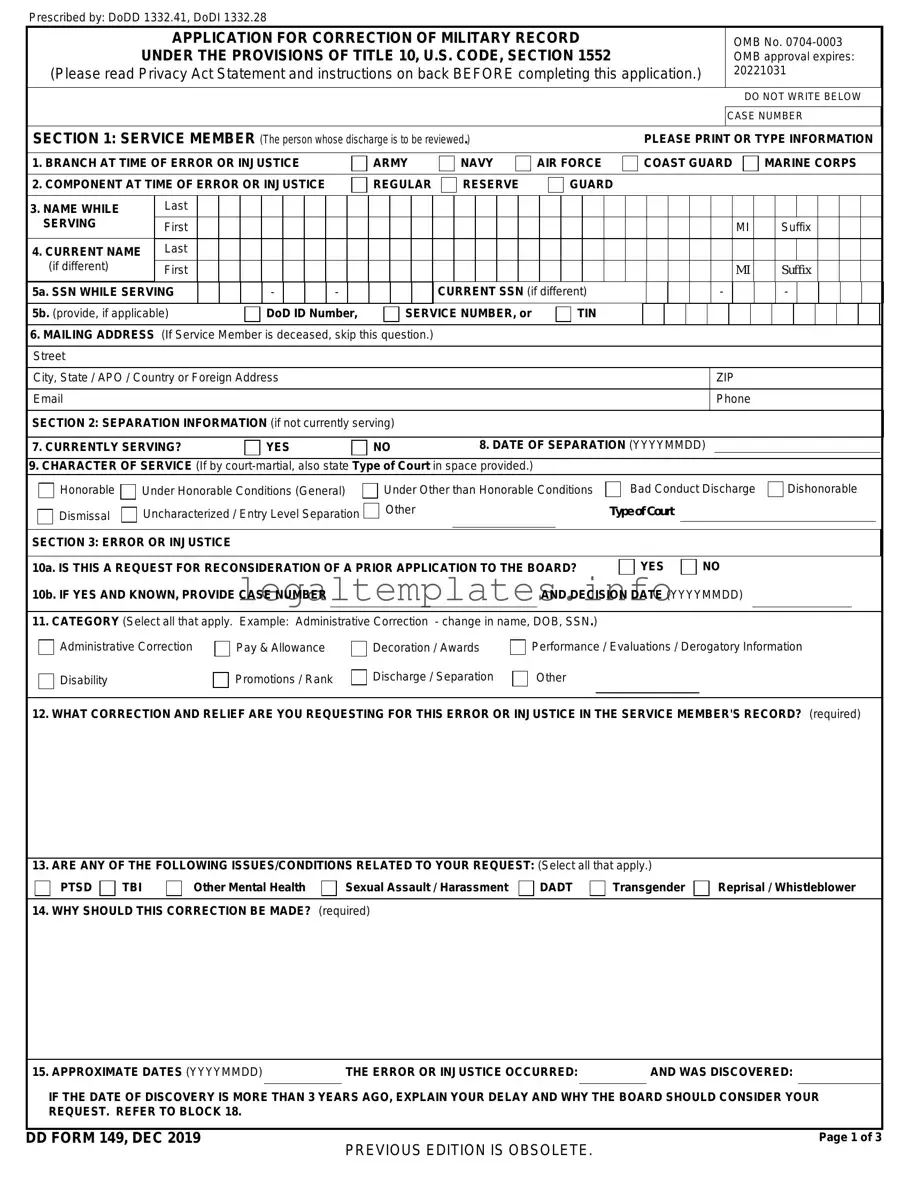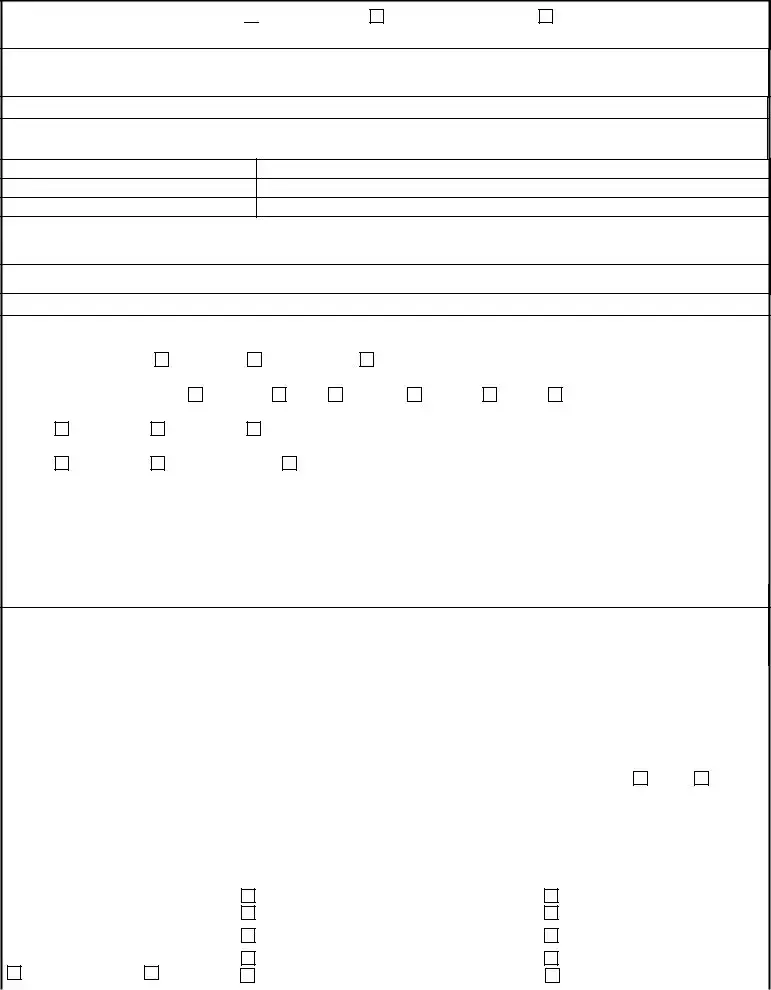Prescribed by: DoDD 1332.41, DoDI 1332.28
INSTRUCTIONS FOR COMPLETION OF DD FORM 149
Under Title 10 United States Code Section 1552, current and former members of the Armed Forces, their lawful or legal representatives, spouses and ex- spouses of former members seeking Survivor Benefit Program (SBP) benefits, and civilian employees seeking correction of military records other than those related to civilian employment, who feel that they have suffered an injustice as a result of error or injustice in military records may apply to their respective Boards for Correction of Military (or Naval) Records (BCMR/BCNR) for a correction of their military records. These Boards are the highest level appellate review authority in the military. Therefore, applicants must exhaust all other administrative correction and appeal procedures before applying to the Boards.
This form collects the basic data that the Boards need to process and act on the request. Type or print all entries for all applicable items. If the item is not applicable, enter "NA." If the space provided is insufficient, attach an extra page.
SECTION 3, ITEM 12. State the specific correction of record and all relief desired. If possible, identify exactly what document or information in your record you believe to be erroneous or unjust and indicate what correction you want made to it. For additional errors or injustices, use Section 8.
ITEM 14. To justify correction of a military record, you must explain and show to the satisfaction of the Board that the alleged entry or omission in the record is in error or unjust.
ITEM 15. U.S. Code, Title 10, Section 1552(b), states that no correction may be made unless the request is made within three years after the discovery of the error or injustice, but the Board may excuse failure to file within three years in the interest of justice.
ITEM 16. Indicate whether you attribute the error or injustice to your involvement in a particular war or contingency operation.
ITEM 17. A hearing is not required to ensure the Board's full and impartial consideration of your application. If the Board decides that a hearing is warranted, you, your witnesses, and your counsel may attend at no expense to the government, except that counsel may be provided if the Inspector General has reported reprisal against you.
SECTION 4. You are responsible for obtaining and submitting clear, legible evidence to persuade the Board to grant your request, including any evidence that is not already in your military record. Do not assume a document is in your record. Your evidence should be submitted with this form and may include, for example, military records and orders, witnesses' sworn affidavits, and a brief of arguments supporting your request. List your evidence in item 19 and, if your case involves a medical condition, submit relevant medical records and VA rating decisions as noted in item 20. Do not send irreplaceable original documents because they will not be returned.
SECTION 5. The person whose record will be corrected if relief is granted must sign this form in Section 7. If that person is deceased or incompetent to sign, a lawful claimant, such as a spouse, widow(er), next of kin (child, parent, or sibling), or legal representative, may sign the form. Proof of death, incompetency, or power of attorney must be submitted. Former spouses may apply as claimants for SBP issues
.
SECTION 6. You may want counsel if your case is complex. Some veterans and service organizations furnish counsel without charge. Contact your local post or chapter.
For detailed information on application and Board procedures, see: Army Regulation 15-185 and www.arba.army.pentagon.mil; Navy - SECNAVINST.5420.193 and www.hq.navy.mil/bcnr/bcnr.htm; Air Force Instruction 36-2603, Air Force Pamphlet 36-2607, and www.afpc.randolph.af.mil/safmrbr; Coast Guard - Code of Federal Regulations, Title 33, Part 52 and www.uscg.mil/Resources/legal/BCMR.
|
MAIL COMPLETED APPLICATIONS TO APPROPRIATE ADDRESS BELOW |
|
|
|
|
|
ARMY |
NAVY AND MARINE CORPS |
AIR FORCE |
COAST GUARD |
Army Review Boards Agency |
Board for Correction of Naval |
Air Force Board for Correction of |
DHS Office of the General Counsel |
251 18th Street South, Suite 385 |
Records |
Military Records |
Board for Correction of Military |
Arlington, VA 22202-3531 |
701 S. Courthouse Rd, Suite 1001 |
3351 Celmers Lane |
Records, Stop 0485 |
http://arba.army.pentagon.mil |
Arlington, VA 22204-2490 |
Joint Base Andrews, MD 20762-6435 |
2707 Martin Luther King Jr. Ave. S.E. |
|
http://www.secnav.navy.mil/mra/bcnr |
http://www.afpc.af.mil/Board-for- |
Washington, DC 20528-0485 |
|
/Pages/default.aspx |
Correction-of-Military-Records/ |
https://www.uscg.mil/Resources/lega |
|
|
|
l/BCMR/ |
The public reporting burden for this collection of information is estimated to average 30 minutes per response, including the time for reviewing instructions, searching existing data sources, gathering and maintaining the data needed, and completing and reviewing the collection of information. Send comments regarding the burden estimate or burden reduction suggestions to the Department of Defense, Washington Headquarters Services, at whs.mc-alex.esd.mbx.dd-dod-information-collections@mail.mil. Respondents should be aware that notwithstanding any other provision of law, no person shall be subject to any penalty for failing to comply with a collection of information if it does not display a currently valid OMB control number.
RETURN COMPLETED FORM TO THE APPROPRIATE ADDRESS ON PAGE 3.
PRIVACY ACT STATEMENT
AUTHORITY: 10 U.S.C. 1552, Correction of military records: claims incident thereto; and E.O. 9397 (SSN), as amended.
PRINCIPAL PURPOSE(S): To initiate an application for correction of military record. The form is used by Board members for review of pertinent information in making a determination of relief through correction of a military record. Completed forms are covered by correction of military records SORNs maintained by each of the Services or the Defense Finance and Accounting Service.
ROUTINE USE(S): The DoD Routine Uses can be found in the applicable system of records notices below:
Army (http://dpcld.defense.gov/Privacy/SORNsIndex/DOD-wide-SORN-Article-View/Article/569931/a0015-185-sfmr.aspx)
Navy and Marine Corps (http://dpcld.defense.gov/Privacy/SORNsIndex/DOD-wide-SORN-Article-View/Article/570411/nm01000-1/) Air Force (https://dpcld.defense.gov/Privacy/SORNsIndex/DOD-wide-SORN-Article-View/Article/569833/f036-safcb-a/)
Defense Finance and Accounting Service (http://dpcld.defense.gov/Privacy/SORNsIndex/DOD-wide-SORN-Article-View/Article/570192/t7340b/) Coast Guard (https://www.gpo.gov/fdsys/pkg/FR-2013-10-02/html/2013-23991.htm)
Official Military Personnel Files:
Army (http://dpcld.defense.gov/Privacy/SORNsIndex/DOD-wide-SORN-Article-View/Article/570054/a0600-8-104-ahrc.aspx) Navy (http://dpcld.defense.gov/Privacy/SORNsIndex/DOD-wide-SORN-Article-View/Article/570310/n01070-3/)
Marine Corps (http://dpcld.defense.gov/Privacy/SORNsIndex/DOD-wide-SORN-Article-View/Article/570626/m01070-6/) Air Force (http://dpcld.defense.gov/Privacy/SORNsIndex/DOD-Component-Article-View/Article/569821/f036-af-pc-c/) Coast Guard (http://www.gpo.gov/fdsys/pkg/FR-2011-10-28/html/2011-27881.htm)
DISCLOSURE: Voluntary. However, failure by a claimant to provide the information not annotated as “optional” may result in a denial of your application. A claimant's SSN is used to retrieve these records and links to the member's official military personnel file and pay record.


 TBI
TBI  Other Mental Health
Other Mental Health  Sexual Assault / Harassment
Sexual Assault / Harassment  DADT
DADT  Transgender
Transgender 
 Reprisal / Whistleblower
Reprisal / Whistleblower


